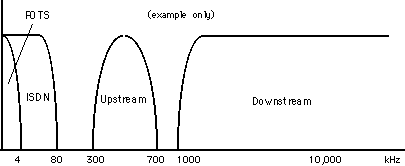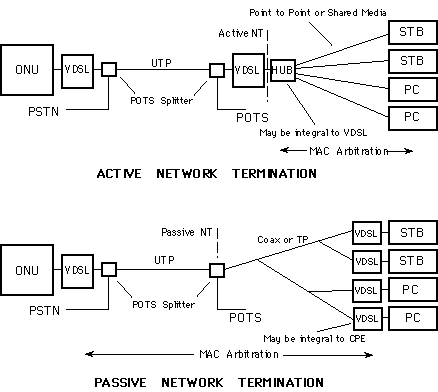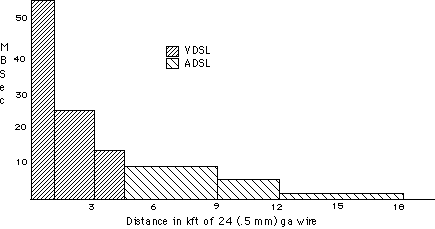

Fiber - Copper Access to the Information Highway
It is becoming increasingly clear that telephone companies around the world are making decisions to include existing twisted-pair loops in their next generation broadband access networks. Hybrid Fiber Coax (HFC), a shared access medium well suited to analog and digital broadcast, comes up somewhat short when asked to carry voice telephony, interactive video, and high speed data communications at the same time. Fiber all the way to the home (FTTH) is still prohibitively expensive in a marketplace soon to be driven by competition rather than costs. An attractive alternative, soon to be commercially practical, is a combination of fiber cables feeding neighborhood Optical Network Units (ONUs) and last leg premises connections by existing or new copper. This topology, which can be called Fiber to the Neighborhood (FTTN), encompasses Fiber to the Curb (FTTC) with short drops and Fiber to the Basement (FTTB), serving tall buildings with vertical drops.
One of the enabling technologies for FTTN is Very high rate Digital Subscriber Line, or VDSL. In simple terms, VDSL transmits high speed data over short reaches of twisted-pair copper telephone lines, with a range of speeds depending upon actual line length. The maximum downstream rate under consideration is between 51 and 55 Mbps over lines up to 1000 ft (300 meters) in length. Downstream speeds as low as 13 Mbps over lengths beyond 4000 ft (1500 meters) are also in the picture. Upstream rates in early models will be asymmetric, just like ADSL, at speeds from 1.6 to 2.3 Mbps. Both data channels will be separated in frequency from bands used for POTS and ISDN, enabling service providers to overlay VDSL on existing services. At present the two high speed channels will also be separated in frequency. As needs arise for higher speed upstream channels or symmetric rates, VDSL systems may need to use echo cancellation.

This monograph presents VDSL in terms of projected capabilities, underlying technology, and outstanding issues. It follows with a survey of standards activity and concludes with a suggestion that VDSL and ADSL together provide network providers an excellent combination for evolving a full service network while offering virtually ubiquitous access to most PC applications and interactive TV applications as the network develops.
VDSL PROJECTED CAPABILITIES
While VDSLhas not achieved the degree of definition of ADSL, it has advanced far enough to discuss realizable goals, beginning with data rate and range. Downstream rates derive from submultiples of the SONET and SDH canonical speed of 155.52 Mbps, namely 51.84 Mbps, 25.92 Mbps and 12.96 Mbps. Each rate has a corresponding target range:
12.96 - 13.8 Mbps 4500 ft 1500 meters
25.92 - 27.6 Mbps 3000 ft 1000 meters
51.84 - 55.2 Mbps 1000 ft 300 meters
Upstream rates under discussion fall into three general ranges:
1.6 - 2.3 Mbps
19.2 Mbps
Equal to Downstream
Early versions of VDSL will almost certainly incorporate the slower asymmetric rate. Higher upstream and symmetric configurations may only be possible for very short lines.
Like ADSL, VDSL must transmit compressed video, a real time signal unsuited to error retransmission schemes used in data communications. To achieve error rates compatible with compressed video, VDSL will have to incorporate Forward Error Correction (FEC) with sufficient interleaving to correct all errors created by impulsive noise events of some specified duration. Interleaving introduces delay, in the order of 40 times the maximum length correctable impulse.
Data in the downstream direction will be broadcast to every CPE in a premises or be transmitted to a logically separated hub that distributes data to addressed CPE based on cell or TDM multiplexing within the data stream itself. Upstream multiplexing is more difficult. Systems using a passive NT must insert data onto a shared medium, either by a form of TDMA or a form of FDM. TDMA may use a species of token control called cell grants passed in the downstream direction from the ONU modem, or contention, or both (contention for unrecognized devices, cell grants for recognized devices). FDM gives each CPE its own channel, obviating a MAC protocol, but either limiting data rates available to any one CPE or requiring dynamic allocation of bandwidth and inverse multiplexing at each CPE. Systems using active NTs transfer the upstream collection problem to a logically separated hub that would use (typically) Ethernet or ATM protocols for upstream multiplexing.
Migration and inventory considerations dictate VDSL units that can operate at various (preferably all) speeds with automatic recognition of a newly connected device to a line or a change in speed. Passive network interfaces need to have hot insertion, where a new VDSL premises unit can be put on the line without interfering with the operation of other modems.
VDSL TECHNOLOGY
VDSL technology will resemble ADSL to a large degree, although ADSL must face much larger dynamic ranges and is considerably more complex as a result. VDSL must be lower in cost and lower in power, and premises VDSL units may have to implement a physical layer media access control for multiplexing upstream data.
Line code candidates
Four line codes have been proposed for VDSL:
Channel Separation
Early versions of VDSL will use frequency division multiplexing to separate downstream from upstream channels and both of them from POTS and ISDN. Echo cancellation may be required for later generation systems featuring symmetric data rates. A rather substantial distance, in frequency, will be maintained between the lowest data channel and POTS to enable very simple and cost-effective POTS splitters. Normal practice would locate the downstream channel above the upstream channel. However, the DAVIC specification reverses this order to enable premises distribution of VDSL signals over coaxial cable systems.

Forward Error Control
Forward Error Control (FEC) will no doubt use a form of Reed Soloman coding and optional interleaving to correct bursts of errors caused by impulse noise. The structure will be very similar to ADSL as defined in T1.413. An outstanding question is whether FEC overhead (in the range of 8%) will be taken from the payload capacity or added as an out-of-band signal. The former reduces payload capacity but maintains nominal reach, while the latter retains the nominal payload but suffers a small reduction in reach. ADSL puts FEC overhead out of band.
Upstream Multiplexing
If the premises VDSL unit comprises the network termination (an active NT), then the means of multiplexing upstream cells or data channels from more than one CPE into a single upstream becomes the responsibility of the premises network. The VDSL unit simply presents raw data streams in both directions. One type of premises network involves a star connecting each CPE to a switching or multiplexing hub; such a hub could be integral to the premises VDSL unit.

In a passive NT configuration, each CPE has an associated VDSL unit. (A passive NT does not conceptually preclude multiple CPE per VDSL, but then the question of active versus passive NT becomes a matter of ownership, not a matter of wiring topology and multiplexing strategies.) Now the upstream channels for each CPE must share a common wire. While a collision detection system could be used, the desire for guaranteed bandwidth indicates one of two solutions. One invokes a cell-grant protocol in which downstream frames generated at the ONU or further up the network contain a few bits that grant access to specific CPE during a specified period subsequent to receiving a frame. A granted CPE can send one upstream cell during this period. The transmitter in the CPE must turn on, send a preamble to condition the ONU receiver, send the cell, then turn itself off. The protocol must insert enough silence to let line ringing clear. One construction of this protocol uses 77 octet intervals to transmit a single 53 octet cell.
A second method divides the upstream channel into frequency bands and assigns one band to each CPE. This method has the advantage of avoiding any media access control with its associated overhead (although a multiplexor must be built into the ONU), but either restricts the data rate available to any one CPE or imposes a dynamic inverse multiplexing scheme that lets one CPE send more than its share for a period. The latter would look a great deal like a media access control protocol, but without the lose of bandwidth associated with carrier detect and clear for each cell.
VDSL ISSUES
VDSL is still in the definition stage; some preliminary products exist, but not enough is known yet about telephone line characteristics, RFI emissions and susceptibility, upstream multiplexing protocols, and information requirements to frame a set of definitive, standardizable properties. One large unknown is the maximum distance that VDSL can reliably realize for a given data rate. This is unknown because real line characteristics at the frequencies required for VDSL are speculative and items such as short bridged taps or unterminated extension lines in homes, which have no affect on telephony, ISDN or ADSL, may have very detrimental affects on VDSL in certain configurations. Furthermore, VDSL invades the frequency ranges of amateur radio, and every above-ground telephone wire is an antenna that both radiates and attracts energy in amateur radio bands. Balancing low signal levels to prevent emissions that interfere with amateur radio with higher signals needed to combat interference by amateur radio could be the dominant factor in determining line reach.
A second dimension of VDSL that is far from clear is the services environment. It can be assumed that VDSL will carry information in ATM cell format for video and asymmetric data communications, although optimum downstream and upstream data rates have not been ascertained. What is harder to assess is the need for VDSL to carry information in non-ATM formats (such as conventional PDH structures) and the need for symmetric channels at broadband rates (above T1/E1). VDSL will not be completely independent of upper layer protocols, particularly in the upstream direction where multiplexing data from more than one CPE may require knowledge of link layer formats (that is, ATM or not).
A third difficult subject is premises distribution and the interface between the telephone network and customer premises equipment (CPE). Cost considerations favor a passive network interface with premises VDSL installed in CPE and upstream multiplexing handled much like local area network busses. System management, reliability, regulatory constraints, and migration favor an active network termination, just like ADSL and ISDN, that can operate like a hub, with point-to-point or shared media distribution to multiple CPE on premises wiring that is independent and physically isolated from network wiring.
But, costs cannot be ignored. Small ONUs must spread common equipment costs, such as fiber links, interfaces, and equipment cabinets, over a small number of subscribers compared to HFC. VDSL therefore has a much lower cost target than ADSL, which may connect directly from a wiring center, or cable modems, which also have much lower common equipment costs per user. Furthermore, VDSL for passive NTs may (only may) be more expensive than VDSL for active NTs, but the elimination of any other premises network electronics may make it the most cost effective solution, and highly desired, despite the obvious benefits of an active NT.
Stay tuned.
STANDARDS STATUS
At present five standards organizations/forums have begun work on VDSL: ANSI group T1E1.4, ETSI, DAVIC, The ATM Forum, and The ADSL Forum.
T1E1.4
The U.S. ANSI standards group T1E1.4 has just begun a project for VDSL, making a first attack on system requirements that will evolve into a system and protocol definition.
ETSI
The European Telecommunications Standards Institute (ETSI) has a VDSL standards project, under the title High Speed (metallic) Access Systems (HSAS), and has compiled a list of objective, problems, and requirements. Among its preliminary findings are the need for an active NT and payloads in multiples of SDH Virtual Container VC-12, or 2.3 Mbps. ETSI works very closely with T1E1.4 and The ADSL Forum, with significant overlapping attendees.
DAVIC
The Digital Audio-Visual Council (DAVIC) has taken the earliest position on VDSL. Its first specification due to be finalized in December of 1995 will define a line code for downstream data, another for upstream data, and a media access control for upstream multiplexing based on TDMA over shared wiring. As of its September 1995 meeting, DAVIC is only specifying VDSL for a single downstream rate of 51.84 Mbps and a single upstream rate of 1.6 Mbps over 300 meters or less of copper. The proposal assumes, and is driven to a large extent by, a passive NT, and further assumes premises distribution from the NT over new coaxial cable or new copper wiring.
The ATM Forum
The ATM Forum has defined a 51.84 Mbps interface for private network UNIs and a corresponding transmission technology. It has also taken up the question of premises distribution and delivery of ATM all the way to premises over the various access technologies described above.
The ADSL Forum
The ADSL Forum has just begun consideration of VDSL. In keeping with its charter, the Forum will address network, protocol, and architectural aspects of VDSL for all prospective applications, leaving line code and transceiver protocols to T1E1.4 and ETSI and higher layer protocols to organizations such as The ATM Forum and DAVIC.
RELATIONSHIP WITH ADSL
VDSL has an odd technical resemblance to ADSL. VDSL achieves data rates nearly ten times greater than ADSL, but ADSL is the more complex transmission technology, in large part because ADSL must contend with much larger dynamic ranges than VDSL. However, the two are essentially cut from the same cloth. ADSL employs advanced transmission techniques and forward error correction to realize data rates from 1.5 to 9 Mbps over twisted-pair ranging to 18,000 feet; VDSL employs the same advanced transmission techniques and forward error correction to realize data rates from 13 to 55 Mbps over twisted pair ranging to 4500 feet. Indeed, the two can be considered a continuum, a set of transmission tools that delivers about as much data as theoretically possible over varying distances of existing telephone wiring.
VDSL is clearly a technology suitable for a full service network (assuming "full service" does not imply more than two HDTV channels over the highest rate VDSL). It is equally clear that telephone companies cannot deploy ONUs overnight, even if all the technology were available. ADSL may be not a "full service network" technology, but it has the singular advantage of offering service over lines that exist today, and ADSL products are closer in time than VDSL. Many new services being contemplated today can be delivered at speeds at or below T1/E1 rates -- video conferencing, Internet access, video on demand, remote LAN access. For such services, ADSL/VDSL provides an ideal combination for network evolution. On the longest lines, ADSL delivers a single channel. As line length shrinks, either from natural proximity to a central office or deployment of fiber-based access nodes, ADSL and VDSL simply offer more channels, and capacity for services that require rates above T1/E1 (such as digital live television or virtual CD-ROM access).


This information came from http://www.adsl.com/vdsl_tutorial.htm
Return to previous menu